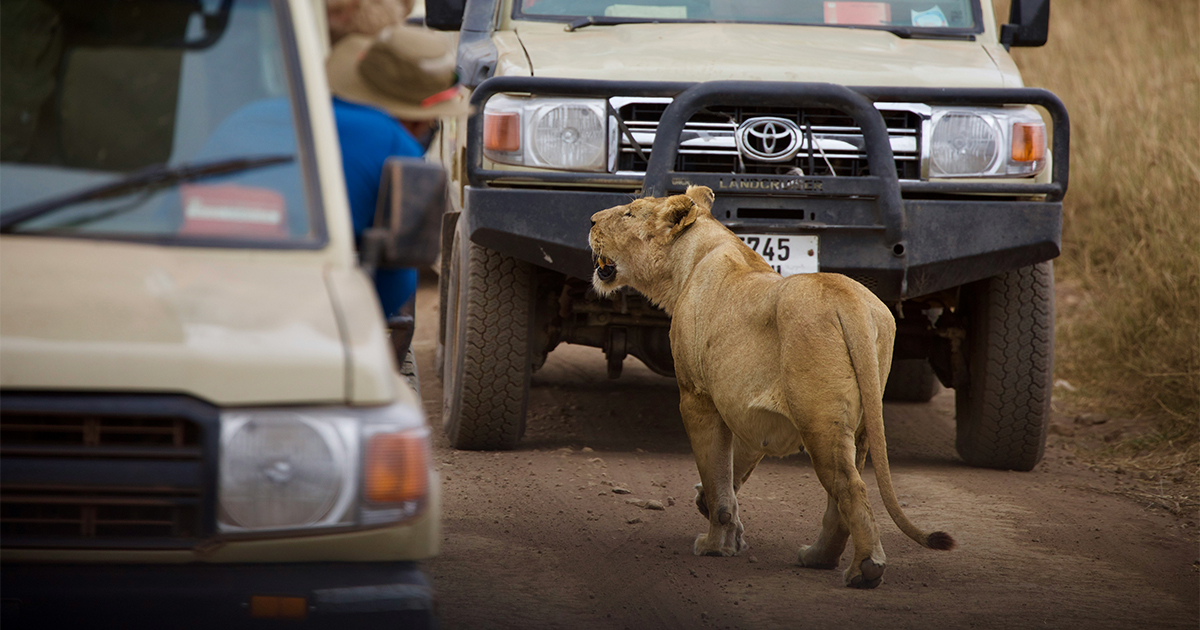
Kenya vs South Africa: Safari Showdown
- byscarfacepride
- - July 26, 2024
Home » Blog » Kenya vs South Africa: Safari Showdown
The wait is over. You have finally decided to make your safari plans a reality. You have planned that extended break from work and are already fantasizing about doing the typical safari activities in the vast African savannahs—watching a giraffe graze across the plains, a lion stalk its prey, or a cheetah sprinting to catch its next meal.
However, it’s not long before you realize that you are still stuck with the biggest confusion about your safari: Kenya vs South Africa.
On one side is Kenya, the motherland of safaris with its panoramic savannahs, the stunning Maasai Mara, and beautiful lakes. On the other side is South Africa, with its varied landscapes, bustling cities, and famed winelands that make for experiences beyond the traditional safari. Which side should you incline towards?
We know it’s confusing, and we are here to do away with your confusion. Keep reading as we guide you through some of the most striking features of a safari in Kenya and South Africa, so that by the end of this blog, you will know which flight tickets to book!
1. Accessibility and Transportation Options

The two safari destinations are connected with the rest of the world via an extensive network of flights and offer convenient transportation options within the country. However, the specifics of the convenience depend on where you are flying from and what you prefer.
Kenya:
Flights to Kenya come in handy from the UAE. There are multiple flights at different times every day from Dubai International Airport (DXB) to Jomo Kenyatta Airport (NBO). Kenya Airways offers direct flights daily between Dubai and Nairobi, as do Air Arabia and Emirates. You can also find flights from Abu Dhabi, but they are not non-stop and are much more costly.
If you are traveling from the US, Kenya Airways offers direct flights almost daily from JFK Airport (JFK) in New York to Jomo Kenyatta Airport (NBO) in Nairobi, so you can reach Kenya in just 14-15 hours. However, if you don’t mind layovers, there are many more flights from New York, Chicago, Seattle, and other major US cities.
Direct flights from the UK and France are also regularly available from Heathrow Airport in London and Charles de Gaulle Airport in Paris, respectively. Australia has no direct flights to Nairobi, but there are many connecting flights from Sydney with layovers in Bangkok, Dubai, Doha, or other cities.
Once in Kenya, you can easily travel to Maasai Mara and other safari regions via road or internal flights. If you have booked via a good tour operator, they will usually take care of it, so you won’t need to worry much about it.
South Africa:
South Africa is just as connected when it comes to flight options.
On any day of the week, you can find multiple Emirates non-stop flights from Dubai (DXB) to Johannesburg (JNB) or Cape Town (CPT). Flights to Johannesburg usually take just over 8 hours, while Cape Town-borne flights take less than 10 hours.
In the US, United Airways flights fly daily from Newark to Johannesburg and Cape Town, while Delta flights fly daily from Atlanta to Johannesburg. From London, British Airways and Virgin Atlantic offer regular direct flights to Johannesburg and Cape Town. If you are from Australia, you can hop on a morning Qantas flight from Sydney and arrive at Johannesburg in just over 14 hours.
South Africa has an extensive and developed transport infrastructure, so you can not only find flights but also take the slower land route and go on road trips across the vast variety of landscapes the country offers.
The Winner:
Both countries are highly accessible and easy to travel to, though you may or may not find a direct flight depending on where you are from. However, when it comes to domestic transportation, South Africa wins because of its developed transport infrastructure that connects most places by road.
2. Wildlife Diversity and Abundance
Both Kenya and South Africa offer diverse wildlife-viewing opportunities. You can spot the Big Five (lion, leopard, elephant, buffalo, rhinoceros) and countless other rare and endangered animals in either place. However, each country offers unique experiences that can’t be found elsewhere.
Kenya:

As the original safari destination, Kenya is popular for its uber-diverse array of animal species that take center stage in a safari. The Maasai Mara is a hub of big cats, such as lions, leopards, and cheetahs, though you will also witness many other wild predators like foxes, jackals, hyenas, and even wild dogs roaming through the plains and hunting down their prey.
One of the biggest highlights of a Kenyan safari is The Great Migration—one of the world’s most spectacular wildlife phenomena. If you arrive here between July and September, you will get a chance to witness over 1.5 million wildebeests and hundreds of thousands of zebras, gazelles, topis, and other animals parading across the plains and crossing the Mara River, creating a sight that goes unparalleled and unrivaled in the animal world.
Besides these animals, the country also teems with many rare and endangered animal species, including the famous Northern Five—Grevy’s zebra, Somali Ostrich, Reticulated Giraffe, Beisa Oryx, and Gerenuk—and over 1100 bird species.
South Africa:
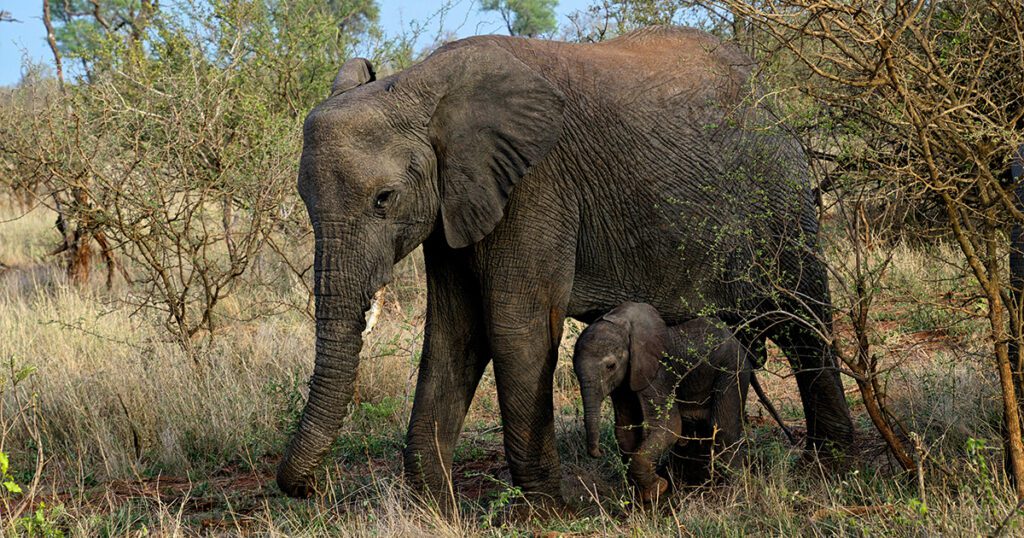
South Africa’s Kruger National Park boasts a large number of elephants and many other large and small animals. You’ll find the endangered black-maned lions in Southern Kalahari, along with Hartmann’s mountain zebra, brown hyenas, and meerkats.
While Kenya has wider range of bird species, South Africa offers a better infrastructure and guides for bird viewing. So, you can readily spot and identify rare, endemic birds like Cape Vulture, Cape Parrot, and Orange-breasted sunbird as you travel to the northern, eastern, and southwestern regions of the country.
However, South Africa outshines Kenya with its rich and diverse marine life. Some coastal regions, such as the Western Cape, Southern Peninsula, and Gaansbai, are home to the Marine Big Five: the bottlenose dolphin, great white shark, southern right whales, the Cape fur seals, and African penguins.
The Winner:
Kenya gets a slight edge because of its sheer number of animals during its peak season and The Great Migration, while South Africa offers consistent variety throughout the year. However, the latter completely outshines Kenya when it comes to its diverse aquatic life.
3. Landscapes and Ecosystems
The more stunning the landscapes, the more fulfilling the safari is. Fortunately, both Kenya and South Africa offer a great mix of diverse landscapes and ecosystems, with a perfect blend of savannahs, mountains, and beaches.
Kenya:
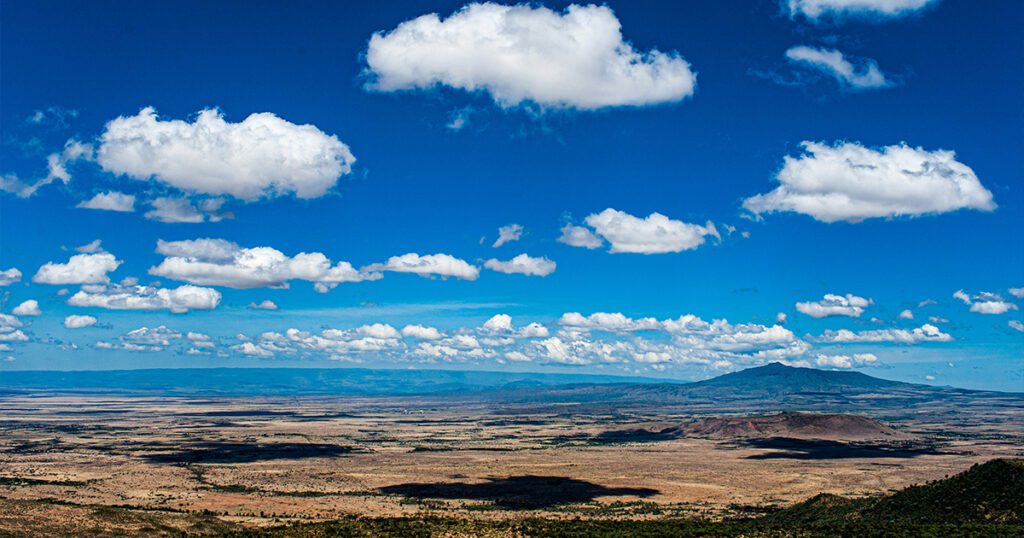
Kenya offers much diversity in its landscapes—from expansive savannahs to scenic valleys to sandy, sun-kissed beaches.
The grasslands in Kenya are extremely vast, stretching far to the horizon and offering sweeping views and a glimpse into the rich wildlife that dwells in the region. The Great Rift Valley boasts many beautiful lakes, which make for stunning sunset spots and offer excellent birding opportunities. For example, Lake Nakuru is home to thousands of flamingos, while Lake Naivasha and its surrounding regions brim with hundreds of bird species.
For mountain lovers, Aberdare Range and Mount Kenya can be the most stunning sights with daunting slopes and snow-capped peaks. And if you are a beach person, the beaches of Mombasa, South Coast, and Lamu archipelago are there to greet you with their white-sand beaches.
South Africa:
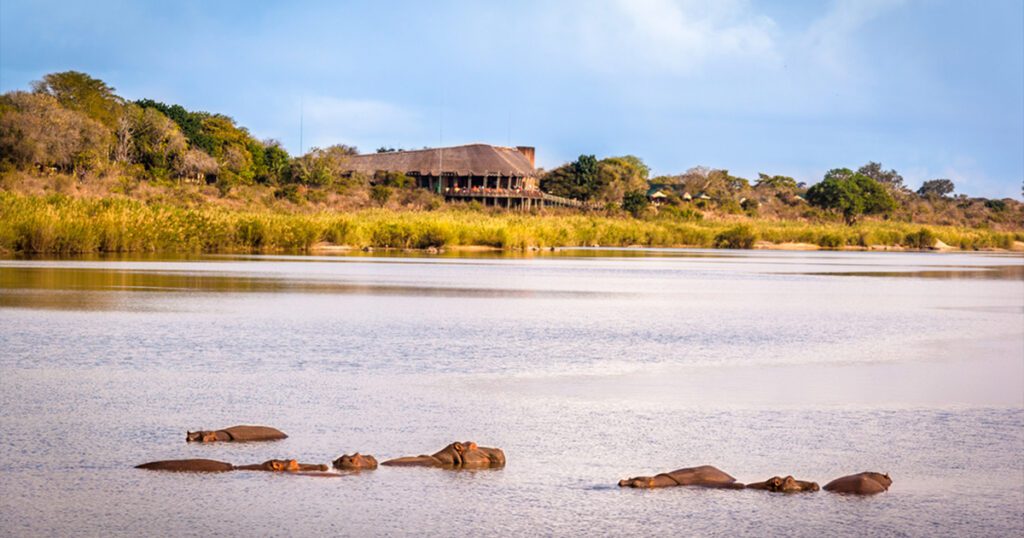
South Africa has enough grasslands to offer the traditional safari feel, though they are not as vast and far-reaching as the ones in Kenya. However, the country is rife with different experiences that can’t be found in Kenya.
Kruger National Park, Sabi Sand Game Reserves, and a few other regions offer the typical savannah experience, with acacia trees spotting the grasslands and rivers cutting through the plains. You can go on game drives, guided walks, and do other typical safari activities you wish to do.
However, the country also has starkly contrasting landscapes beyond the traditional safari savannahs. You will come across dense forests while exploring the Tsitsikamma National Park and Garden Route, rugged peaks and deep valleys while hiking the Drakensberg Mountains, and red sand dunes of the Kalahari Desert in the Northern Cape province.
If you just want to chill, you can hop on a car and explore the bustling city of Cape Town for its exuberance, nightlife, and great gourmet food!
The Winner:
Kenya is a clear winner if you want your trip to be mostly about safari and natural retreats. However, South Africa offers a much wider range of landscapes and lets you indulge in a more diverse mix of traditional and modern activities.
4. Accommodation Options and Quality
There is no dearth of excellent accommodations in Kenya and South Africa, as both offer comfortable, spacious, and luxurious stay options. However, the meaning of “luxurious” notably varies between the two countries.
Kenya:
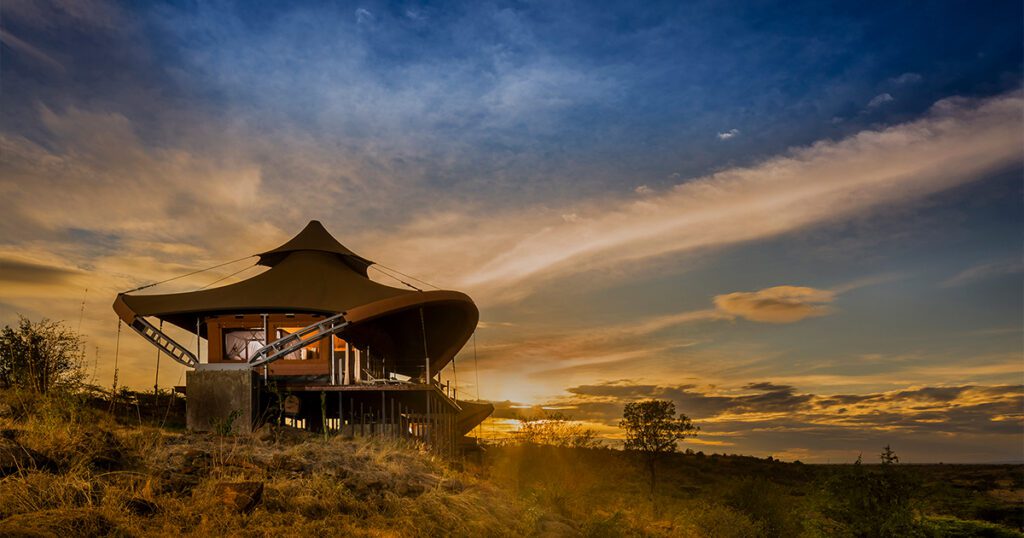
Authentic tented camps reign supreme in Kenya. You will find tented camps and lodges across the Maasai Mara National Park and throughout the Great Rift Valley.
All these camps are nestled in the wilderness amid nature, complete with all the essential amenities like electricity, Wi-Fi, hot showers, and dining areas. You may not find some advanced facilities like air conditioning and private pools in most camps. But this lack is somewhat compensated for by the breathtaking views around your camps and the luxury of sleeping under a star-studded night sky that many camps offer.
South Africa:
South Africa also offers a wide range of accommodations, including tented camps. But it goes way ahead with its extensive offering of luxury lodges that feel like second homes outside your home.
“Luxury” in South Africa includes air-conditioned lodges with private plunge pools and gourmet dining experiences. So, instead of high-end tented camps, you will see more exquisite 5-star lodges offering modernistic architecture blended with classic African aesthetics.
The Winner:
If you are looking for a more rugged, culturally rich experience, Kenya is your go-to place, as it offers a closer connection to nature and provides better opportunities to mingle with the locals. However, South Africa provides more comfort and ease of travel, with a special focus on luxury. So honestly, it depends on what kind of experience you are looking for!
5. Additional Experiences Beyond Safaris
The overall quality of your safari depends not just on your safari-centric experiences but also on all the other things you can do on the trip. Interestingly, both Kenya and South Africa offer great complementary experiences to top off your safari and make it many times more memorable!
Kenya:

A safari in Kenya comes with several additional perks. You can enjoy thrilling hot-air balloon rides across the Maasai Mara, go on cultural tours to Maasai villages, and hop on a camel to explore the desert landscape of Samburu National Park.
Once you have had a fulfilling safari experience, heading to the National Museum in Nairobi can be a great idea to dive into Kenya’s history and culture. You can also get on a one-hour flight from the capital to Mombasa and loll on the white-sand beaches of the South Coast.
Or, if you are an adventure seeker, you can climb to one, two, or all of the three peaks of the 17,000-foot-tall Mount Kenya. Imagine trekking through scenic slopy trails while being awestruck by the breathtaking views of lakes, glaciers, valleys, springs, and montane forests. What fun would it be!
South Africa:

South Africa has its fair share of off-safari experiences. The country’s cultural and geographical diversity makes for arguably the most well-rounded safari experience ever.
You can drive east from Cape Town and head to the international whale-watching hub of Hermanus. If you are here during the winter and spring seasons (June to December), you’ll get to watch many Southern Right whales breaching, spouting, and diving as they stop by near the shore on their annual migratory trip from Antarctica.
Driving along the N2 national highway, you can also reach Mossel Bay and kick off your journey along the stunning Garden Route. It’s a scenic 190-mile-long coastline that runs across pristine beaches, lush forests, lagoons, and mountain ranges all the way to Storms River in the Eastern Cape.
If you want to get into the country’s history and culture, you can head to the KwaZulu-Natal province to learn a few things about the Zulu people. The country is also home to an extensive network of vineyards, something Kenya simply doesn’t have. You can stop by one of the wineries and treat yourself to a pint of Pinotage—South Africa’s signature varietal—and other classic wines.
The Winner:
Kenya offers many off-safari experiences within and beyond the safari. But South Africa has a clear edge because of its sheer range of activities—from deep nature dives to long road trips, wine tasting, and city life.
6. The Cost Factor

All experiences and other factors aside, the overall cost you will have to bear during your trip to Kenya or South Africa is one of the essential factors to consider. And as it turns out, we seem to have a clear winner here.
Kenya:
If you decide to visit Kenya, you must pay for most of your trip and experiences in US dollars. So, your overall cost considerations will come down to the exchange rate between your native currency and the USD. The USD effect is also reflected in the high cost of accommodations in the high-end tented camps available across Kenya.
Moreover, traveling across Kenya is often facilitated by short internal flights, which may cost a lot of money. Unless you are in Nairobi, you won’t find extensive road transportation and self-driving options, which are more budget-friendly. Finally, national park fees in Kenya tend to be slightly higher than in South Africa.
South Africa:
South Africa has some notable advantages over Kenya when it comes to overall costs, starting with the prevalence of the South African Rand instead of the Dollar. Since the South African Rand is much weaker than the Dollar, the prices of your experiences tend to be notably lower than comparable experiences in Kenya.
A wider range of accommodation also lets you adjust your costs according to your budget constraints. And since the country has a much more developed infrastructure, traveling by road is readily available and much more affordable. What’s more, you can diversify your trip beyond the safari to other great opportunities like road trips, hiking, and many other activities to make the most of your trip.
The Winner:
While the precise amount you spend on your safari heavily depends on your personal preferences and plans, South Africa proves to be slightly more budget-friendly because of its currency, wider range of accommodations, and off-safari options.
Other Factors: Safety, Malaria, and More
Besides the above factors, there are some other minor but equally crucial factors that you must consider before taking your call about your ideal safari destination.
Safety:
First comes safety. Fortunately, both countries make the cut for being safe destinations for individuals and families. Rest assured, your tour operator will usually take care of your and your family’s safety, and you won’t have to worry much. Nevertheless, you should be reasonably vigilant and careful, as you should in any new place.
Malaria and Other Diseases:
Malaria is a common and valid concern for anyone visiting an African country. As it turns out, it is a concern in both countries.
While it’s not a big concern, as you can prevent it with some common antimalarial medications, South Africa does have a lower risk and boasts many malaria-free zones. If you want to steer clear of other common diseases prevalent in Africa, you should consider getting vaccinated for Yellow Fever and other diseases before traveling to either country.
Peak Seasons:
Lastly, you would also want to consider the best time to go on a safari in these countries. In Kenya, the peak season is from July to October since it is the dry season and the time of the famous Mara River crossings. In South Africa, though, the period between May and September is more active because of the dry season and better wildlife-viewing opportunities.
You can weigh these considerations to better understand what suits you best. After all, these are not plus or minus points but just the factors that make the two countries different.
The Verdict: Kenya or South Africa?

Choosing between Kenya and South Africa for the best safari destination is like choosing between apples and oranges for the best fruit. In other words, it’s a highly subjective decision that depends on what you want rather than which is better!
If safari for you means a raw, unfiltered experience amid nature, away from the luxuries and intricacies of modern life, Kenya will undoubtedly come closest to your preferences. However, if you want a well-rounded safari with the elements of ruggedness and a complete modern tour package topped off with luxury and adventure, you should head to South Africa.
So, weigh down your negotiables and non-negotiables, and see which of the two countries fits the bill for you as the best safari destination!
